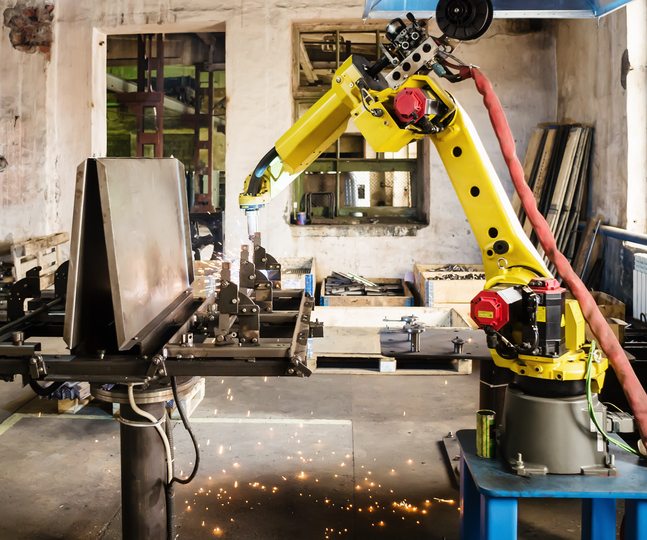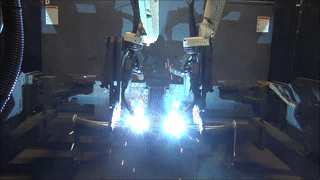The Pros and Cons of Automated Welding
Robotics-enabled automated welding can provide large gains in productivity, profitability, precision, and repeatability - in the right applications. Manual welding has its merits, but the benefits of automated welding systems are increasingly compelling for many assemblies. However, many assemblers are implementing automated welding systems to increase quality, productivity, profitability, precision, and repeatability.
Welding automation can be broken down into two basic categories: semiautomatic and fully automatic. In semiautomatic welding, an operator manually loads the parts into the welding fixture. A robotic weld controller then keeps the welding process, motion of the torch, and stillness of the parts to robotically-optimized preset parameters that ensure quality and efficiency. After the weld is completed, the operator removes the completed assembly and the process begins again.
In fully automatic welding, a custom robotic system, or series of interconnected robotic machines, loads the workpiece, indexes the part or torch into position, accomplishes the weld, monitors the quality of the joint and unloads the finished product. Additional "part in place" and final product quality checks may also be designed into the machine if necessary. Depending on the operation, a robotic system operator may still be necessary for oversight, but the level of autonomy significantly reduces the margin for human error.
Benefits of Automated Welding
Robotics-enabled automated welding systems offer four main advantages: improved weld quality, increased output, decreased scrap and decreased variable labor costs.
Weld quality consists of two factors: weld integrity and repeatability. Robotics-enabled automated welding systems ensure weld integrity through electronic weld process controllers. Combining mechanized torch and part motions with electronic recall of welding parameters results in a higher quality weld than can be accomplished manually. This offers instantaneous quality control. Furthermore, because a weld is made only once, defects are readily visible and detectable. Humans tend to "smooth over" a mistake with the torch, hiding lack of penetration or a possibly flawed weld. In some cases, leak testing and vision systems can be integrated into fully automated systems to provide additional quality control.
Repeatability is a function of the quality of the weld process controller and of the engineering of the machine motions. Mechanized welding provides repeatable input parameters for more repeatable output. Assuming the controller is functioning properly, the question becomes: Can the mechanisms of the machine position the parts or the torch within the specified tolerances for welding? The answer to this question will attest to the quality of the system purchased.

Semiautomatic and fully automatic systems increase output by eliminating the human factor from the welding process. Production weld speeds are set at a percentage of maximum by the machine, not by an operator. With minimal setup time and higher weld speeds, a mechanized welding system can easily outpace a skilled manual welder.
Automating the torch or part motions, and part placement, reduces the possibility of human error. A weld takes place only when all requirements are satisfied. With manual welding, reject welds often increase when welders become fatigued. Depending on the value of the parts when they arrive at the welding station, the cost savings in scrap alone may justify the purchase of an automated welding system. Automation should also be considered when assemblers need to minimize the risk of shipping a bad part to a customer.
Reliance on human welders can dramatically increase a manufacturer’s labor costs. When planning for labor costs, manufacturers must consider the time that welders spend producing assemblies.
Typically, a semiautomatic system has at least 2x the output of a skilled welder. A fully automatic system can be built with twin welding positioners on an automated shuttle. Such a system can load and unload parts at one station while welding occurs at the other. In this way, a fully automatic system can run at four times the pace of semiautomatic system, or eight times faster than the pace of a skilled welder.

Lost opportunity costs are also significant. If a skilled welder fails to report to work, the company’s variable costs skyrocket. Eight hours of production time is lost. Availability of skilled labor for manual welding may also pose a challenge. Conversely, general machine operators are more readily available and more affordable than skilled labor.
Cons of Purchasing an Automated Welding Machine
Despite all the benefits, welding system automation is accompanied by some drawbacks. Although the drawbacks can be controlled, they should be recognized from the onset of an automated welding project.
Robotics-enabled automated welding systems require a higher initial investment than manual systems. A modern manual welding power supply costs less than $5,000; semiautomatic systems often start around $30,000. Companies considering fully automated welding systems should budget $175,000 to $250,000 for a turnkey system.
When shifting from labor-intensive to capital-intensive processes, companies must adopt and rigorously follow preventive maintenance programs. While the gains in productivity, profitability, precision, and repeatability can be outstanding, an effective preventive maintenance program must be followed to minimize the risk of costly downtime.
However, what if I told you there was a way to avoid all of this, and still automate? With Formic's RaaS model, you pay nothing upfront for the system, you never have to worry about maintenance, and you get 24/7 support. All for one low monthly rate that’s almost always cheaper than the labor equivalent, comes with a much higher throughput and lower rework rate.
Find out which robotic welding is right for you
Before investing large sums in automation, assemblers should consider the product life cycle. Most products follow a predictable pattern of introduction, growth, maturity and decline. Assemblers would be ill-advised to sink cash into automating the assembly of an eight-track tape player. On the other hand, the demand for airbag elements and automotive emission sensors will probably remain strong for years.
Deciding to Automate
With quality and productivity as buzzwords, and customers demanding superior products, implementing an automated welding system may determine whether a company remains competitive. To avoid pitfalls along the way, assemblers need to establish a strategy and follow it closely, and research how to get started with robotic automated welding.
First, assemblers should determine the exact objectives of the project. What specifically needs to be improved, accelerated or changed through automated welding? The following questions can help assemblers sort this out:
- Does the function of the part depend on a high-quality weld? What are the ramifications if the end customer receives or uses a defective part?
- What level of automated welding system will the production system justify?
- What metals are involved? Do they lend themselves to automation?
- How is the joining process currently being done? What is unsatisfactory about it?
- What budget is available for the welding portion of the project?
Once assemblers have answered these questions, the next step is to thoroughly research automation suppliers. Fromic helps answer these questions, and lends you automation experts to guide you through your welding automation process.
Download the Free Guide: How to Get Started with Robotic Automation
Automating with Formic, the only question manufacturers need to ask themselves is: what repetitive manual tasks can be automated in my facility right now?


